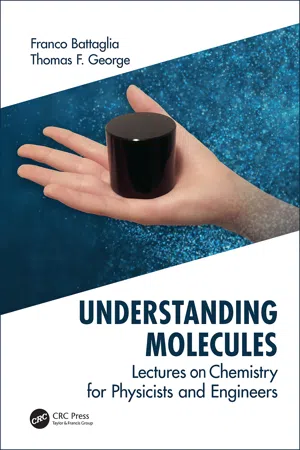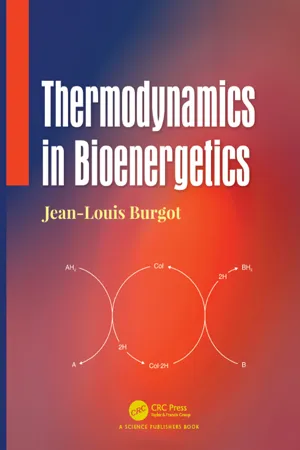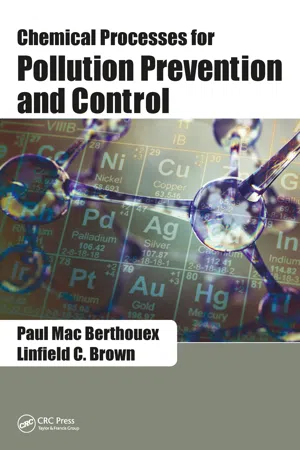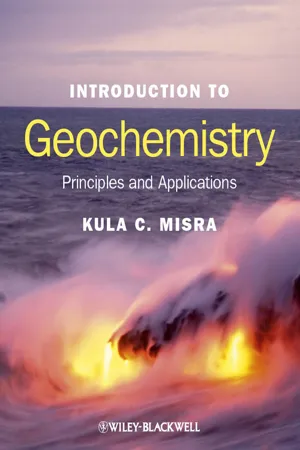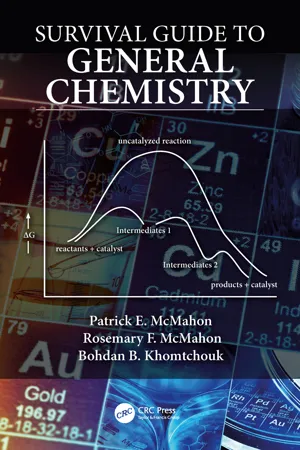Chemistry
Ionic Product of Water
The ionic product of water, also known as the ionization constant of water, is a measure of the concentration of ions in water. It is represented by the equation Kw = [H+][OH-], where [H+] and [OH-] are the concentrations of hydrogen and hydroxide ions, respectively. At 25°C, the ionic product of water has a constant value of 1.0 x 10^-14.
Written by Perlego with AI-assistance
Related key terms
Related key terms
1 of 4
Related key terms
1 of 3
7 Key excerpts on "Ionic Product of Water"
- eBook - ePub
Understanding Molecules
Lectures on Chemistry for Physicists and Engineers
- Franco Battaglia, Thomas F. George(Authors)
- 2018(Publication Date)
- CRC Press(Publisher)
S is the solvent molecular weight]As a consequence of all of the above, an appropriate thermodynamic constant for the equilibrium (12.1 ) isK w( T ) ≡ [H 3O +] [ OH -] ,( 12.3 )known as the Ionic Product of Water . Its value, as specified, depends on temperature, ranging from 3 × 10−15 at 10°C to 3 × 10−13 at 90°C, and it is 1.01 × 10−14 at 25°C. The reaction 2 H2 O → H3 O+ + OH– (called the reaction of autoprotolysis of water ) is apparently endothermic, since an increase of temperature entails an increase of the equilibrium constant [Eq. (11.16 )].The equilibrium (12.1 ) is often written in the simplified formH 2O ⇌H ++ OH -,( 12.4 )thus corresponding to the equilibrium for the reaction H2 O → H+ + OH− (called the dissociation reaction of water ). We should be aware, though, that the proton, H+ , in solution exists not free but it is rather solvated , i.e., surrounded by water molecules of solvation, and writing H3 O+ reminds us of this circumstance. This writing, furthermore, is well suited to the acid–base theory we are going to present in the present chapter. However, unless it is strictly needed, from now on, we shall use the simplified form H+ rather than H3 O+ . In what follows, moreover, we shall consider our systems to be at the temperature 25°C, and for the water ionic product, we shall take the valueK w≡ [H 3O +] [ OH -] = 10- 1 4at 25 ° C.( 12.5 )In pure water, then, [H+ ] = [OH− ] = 10−7 mol/L.12.2 ACIDS AND BASES
It is certainly possible that still with the value (12.5 ) kept constant, the ionic concentrations differ from each other. This occurs when suitable compounds are dissolved into water. Those, when added to water, that increase the value of [H+ ] (and, consequently, decrease the value of [OH− ]) are called acids ; those compounds that, instead, increase the value of [OH− ] (and, consequently decrease the value of [H+ ]) are called bases (or alkali ). From this qualitative definition follows a possible operational definition of acid and base : an acid is a compound which in aqueous solution frees [H+ ] ions, and a base is a compound which in aqueous solution frees [OH− ] ions. For instance, in aqueous solution dissociates as HCl → H+ + Cl− , and it is an acid, called hydrochloric acid; NaOH in aqueous solution dissociates into NaOH → Na+ + OH− - eBook - ePub
- Jean-Louis Burgot(Author)
- 2019(Publication Date)
- CRC Press(Publisher)
(This remark anticipates a brief comparison between acid-base and redox processes which is done later see the following chapter). In aqueous solutions, Arrhenius and Brönsted-Lowry theories can be considered as being equivalent. 2) Quantitative aspects of acid-base reactions 2-1) Ionic Product of Water Water, even purissime, is slightly ionized. This has been discovered thanks to electrical measurements. Its ionization is the mark of the following equilibrium: H 2 O + H 2 O ⇌ H 3 O + (w) + OH − (w) The mass law permits to write: K = a H 3 O + a OH − / a H 2 O 2 where K is the equilibrium thermodynamic constant of the reaction above. Electrical measurements give the following concentrations, for pure water at 25°C: [ H 3 O + ] = [ OH − ] = 10 − 7 mol L − 1 Thus, pure water, even “purissime”, contains ions but very few. As a consequence, the molar fraction of molecular water can be safely taken to be equal to unity and its activity as well (see Chapter 19). As a result, one can write: K = a H 3 O + a OH − (152) The product a H3O+ a OH is named the ion-product constant for water or Ionic Product of Water and is symbolized by K w : K w = a H 3 O + a OH − The ionic product varies with temperature. Dissociation increases with it: at 25 ° C K w = 10 − 14 at 50 ° C K w = 5, 6 10 − 14 at 100 ° C K w = 6, 0 10 − 13 In every aqueous solution, which is diluted in ions, the Ionic Product of Water is a constant at a given temperature, no matter what the OH − and H 3 O + ions concentrations may be, provided the solution remains diluted. It is said: “the water ion product is satisfied”. Solutions for which: [ H 3 O + ] = [ OH − ] are said neutral, [ H 3 O + ] > [ OH − ] are said acidic, [ H 3 O + ] < [ OH − ] are said basic. 2-2) Constant of dissociation acid Ka (pKa) For one acid, in dilute aqueous solution, one defines the acid dissociation constant K a by: K a = a H + a A − / a HA (153) where a H+, a A, a HA are the activities of the species symbolized in subscript - Paul Mac Berthouex, Linfield C. Brown(Authors)
- 2017(Publication Date)
- CRC Press(Publisher)
b is a base ionization constant.If one of the substances is a solid (crystal or precipitate), K is called a solubility product and for clarity is indicated byKsp. The convention is to write the reaction as though the solid, Aa Bb , is dissolved.Aa Bb ⇆ a A + b BThe activity of the solid [Aa Bb ] is one, so the equilibrium reaction becomesK=s p= [[A] a[B] b[A aB b]A] a[B] bThis chapter is about ionization reactions. Chapter 8 is about solubility and precipitation.7.3 IONIZATION OF WATER
Water molecules act as both acids and bases. One water molecule acting as a base can accept a hydrogen ion from another that acts as an acid.+AcidH 2O⇆BaseH 2O+Hydronium ionH 3O +OH –Hydroxyl ionH3 O+ is the hydronium ion and OH− is the hydroxyl ion. This is often written in a simplified formH2 O ⇆ H+ + OH−The reversible reaction isForward reaction H2 O → H+ + OH−Reverse reaction H2 O ← H− + OH−This reaction is so fast that it will always be at equilibrium. Many important reactions in environmental systems are fast and equilibrium can be assumed without serious error. At 25°C, pure water has pH = 7 and[H+ ] = [OH− ] = 10−7 moles per liter (mol/L)The ionization constant at standard temperature and pressure (25°C, 1 atm) isKW= [H+ ][OH− ] = 10−14This means that the product of hydrogen ion concentration and hydroxyl ion concentration always equals 10−14 . If [H+ ] is known, [OH− ] is easily calculated, and vice versa. Changing [H+ ] by adding an acid will simultaneously change [OH−- eBook - ePub
- Ian Bradbury, John Boyle, Andy Morse(Authors)
- 2014(Publication Date)
- Routledge(Publisher)
activity , which is a corrected concentration allowing for non-ideal behaviour; in normal dilute freshwater activity ≈ concentration) of hydrogen ions. When an expression is given in concentration notation, i.e. by use of square brackets, there will normally be a known coefficient which can allow us to constrain the concentrations.At any given temperature, the product (in the mathematical sense of the result of multiplication) of the dissociated ions from the reaction above is constant. This can be expressed as:Figure 42.1 Ions dissolved in water have a mantle of water molecules each orientated to minimize the electrical potential energy. (a) The Large chloride ions are surrounded by many water molecules; (b) the smaller sodium ion has space for six water molecules, which take up an octahedral arrangement.[H+ ] × [OH− ] = k wwhere k w is known as the dissociation constant of water. The value of k w varies with temperature but is relatively constant at normal temperatures and is usually quoted as 10−14 .This expression is more useful than it looks. It tells us three very important things:- It tells us that the [H+ ] and [OH− ] concentrations are not independent of each other.
- If we know the value of one, we can calculate the value of the other, i.e. [H+ ] = k w /[OH− ] and [OH− ] = k w /[H+ ].
- In pure water it allows us to calculate the concentrations of both [H+ ] and [OH− ].
[H+ ] = [OH− ] = √k wThis is then √10−14 which is equal to 10−7 . Therefore:From this we can find the pH of pure water, because:[H+ ] = [OH− ] = 10−7pH = −log10 [H+ ]Thus, if [H+ ] = 10−7 , then:which evaluates to:pH = −log10 [10−7PH = −(−7) = 7(The arithmetic manipulations carried out here are introduced in 26 .)This makes a complete chemical model for pure water if allowance is made for the effect of temperature on k w - eBook - ePub
- J Fisher, J.R.P. Arnold, Julie Fisher, John Arnold(Authors)
- 2020(Publication Date)
- Taylor & Francis(Publisher)
2 NH1.00 × 10−2Aniline (C6 H5 NH2 )3.8 × 10−10....Dissociation in terms of conjugate acids and bases
It has been noted that even very pure solvents display a very small electrical conductance, which can be rationalized by their tendency to produce ions by self-ionization. In the general case this may be represented as follows;As the extent of ionization is very small, the activity of the unionized solvent is correspondingly small and hence the following expression may be derived;KI is known as the ionic product. Hence, for water the ionic product is given as follows;and Kw is the ionic product specifically for water. Kw for pure water at 25°C is 10−14 .If the expressions for the rate constants for acid and base dissociations are considered and their product is derived, it can be seen that this is equivalent to the ionic product of water.This result suggests that the strengths of a conjugate acid and base in the same solvent must be in inverse ratio to one another; the greater the strength of the acid the weaker the strength of the conjugate base. Consequently, it is generally sufficient to talk about only one dissociation constant and this is usually that for acid ionization.Passage contains an image
N3 Acidity and alkalinity of aqueous solutions
DOI: 10.1201/9780203079522-56Key NotespHIn a sample of pure water, (solvated) hydrogen ions and hydroxide ions form by the process of self-ionization. Water is said to be neutral, as the concentration of each of these ions must be equivalent. Thus, as the ionic product for water, Kw , is 10−14 M at room temperature, the concentration of each of the ions must be 10−7 M under the same conditions. Hence, in general if the concentration of hydrogen ions in solution is greater than 10−7 M then the solution is said to be acidic, if the concentration of H+ - eBook - ePub
Introduction to Geochemistry
Principles and Applications
- Kula C. Misra(Author)
- 2012(Publication Date)
- Wiley-Blackwell(Publisher)
− ions do not occur as isolated ions in water; they actually occur as hydrated ions but we write them as though they were not hydrated.Following the definitions stated above, the dissociation of an acid (Hm An ) and a base (Bp OHq ) at equilibrium may be represented as(7.10)(7.11)whereairepresents activity of the species i , aHm Anand aBp OHqrefer to undissociated acid and base molecules in the solution, and K a and K b are the equilibrium constants, which are commonly referred to as dissociation constants to emphasize the nature of the reactions. The higher the value of a dissociation constant, the greater is the degree of dissociation (D ) of the acid or the base, which is calculated as follows:(7.12)(7.13)Note that the percent dissociation of an acid or a base is defined as the ratio of the amount dissociated relative to the total amount originally present, not the ratio of the concentrations of dissociated and undissociated acid/base at equilibrium.Some acids (e.g., HCl, HNO3 , H2 SO4 ) are referred to as strong acids because they dissociate almost completely when dissolved in water (i.e., they release most or all of their H+ ions). In the case of complete dissociation, the value of K a is undefined because the activity of the undissociated acid is zero. Weak acids (e.g., CH3 COOH, H2 CO3 , H3 PO4 , H4 SIO4 ) dissociate only to a small extent (i.e. they release only a small fraction of their H+ ions into the solution). Similarly, bases are classified as strong (e.g., hydroxides of alkali and alkaline-earth elements) or weak (e.g., NH4 OH, Mg(OH)2 , Fe(OH)3 - eBook - ePub
- Patrick E. McMahon, Rosemary McMahon, Bohdan Khomtchouk(Authors)
- 2019(Publication Date)
- CRC Press(Publisher)
HX.(5) Preliminarily, balance the reactants by matching the number of H+ ions to the corresponding number of base acceptors; complete this initial balance by determining the correct coefficient for the resulting first product.(6) Write the correct formula of the other product by combining the remainder of the acid molecule (Acid− without the H+) with the remaining part of the base molecule.a) This product is often the ionic compound produced when the negative ion portion of the acid combines with the positive ion portion of the base.b) The reaction of an acid with ammonia is a special case in which only one compound from steps (4) and (5) is formed.(7) Complete the formula format of the equation by finishing any balancing if required and determining the correct states of matter for all species; use the solubility guidelines for aqueous solubility.(8) Write the total ionic format of the reaction equation.a) Write the aqueous soluble ionic products as separate ions with the (aq) designation; non-soluble ionic compounds are written as intact solid (s) compounds.b) Write all strong acids as aqueous ions based on the ≈100% ionization reaction of strong acids in water; all weak acids are written as neutral covalent intact aqueous (aq) molecules based on ionization of less that 1% to 5%.(9) Write the net ionic equation by canceling exactly identical species from both sides of the total ionic equation.Example: Complete the following reaction and write all three equation formats: Aqueous sulfuric acid (strong acid) is reacted with aqueous potassium hydroxide.(1)H 2SO 4( aq )+KOH→( aq )(2) H2 SO4 transfers two H+ ions;(3) The base portion of KOH is OH− ; each OH− accepts one H+(4)(5) Two KOH are required to accept the two H+ ions from one H2 SO4 ; two H+ transferred to two OH−
Index pages curate the most relevant extracts from our library of academic textbooks. They’ve been created using an in-house natural language model (NLM), each adding context and meaning to key research topics.
Explore more topic indexes
Explore more topic indexes
1 of 6
Explore more topic indexes
1 of 4
